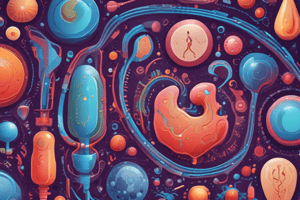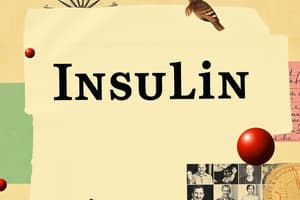Podcast
Questions and Answers
Which of the following is the primary mechanism by which insulin lowers blood glucose levels?
Which of the following is the primary mechanism by which insulin lowers blood glucose levels?
- Promoting the breakdown of glycogen into glucose in the liver.
- Inhibiting gluconeogenesis in the kidneys.
- Facilitating the absorption of glucose into cells, promoting fat and protein synthesis. (correct)
- Stimulating glucagon secretion from alpha cells in the pancreas.
During periods of fasting, how does the body primarily maintain adequate blood glucose levels?
During periods of fasting, how does the body primarily maintain adequate blood glucose levels?
- By increasing insulin secretion to mobilize stored glucose.
- Through glycogenolysis in the pancreas and glucose absorption in the small intestine.
- Via glyconeogenesis in the muscles and kidneys.
- Through glycogenolysis in the liver and gluconeogenesis from amino acids. (correct)
Which of the following hormones does NOT directly promote an increase in blood glucose levels?
Which of the following hormones does NOT directly promote an increase in blood glucose levels?
- Cortisol
- Growth Hormone
- Glucagon
- Insulin (correct)
Why is the brain uniquely vulnerable to conditions that alter blood sugar levels?
Why is the brain uniquely vulnerable to conditions that alter blood sugar levels?
What is the underlying cause of hyperglycemia in individuals with diabetes mellitus?
What is the underlying cause of hyperglycemia in individuals with diabetes mellitus?
A patient presents with acute onset of diabetes, is lean, and was diagnosed at age 16. Based on this information, which type of diabetes mellitus is most likely?
A patient presents with acute onset of diabetes, is lean, and was diagnosed at age 16. Based on this information, which type of diabetes mellitus is most likely?
What is the primary mechanism behind the development of type 1 diabetes mellitus?
What is the primary mechanism behind the development of type 1 diabetes mellitus?
Which of the following best describes the underlying cause of hyperglycemia in type 2 diabetes mellitus?
Which of the following best describes the underlying cause of hyperglycemia in type 2 diabetes mellitus?
What dietary adjustment is most beneficial for managing blood glucose levels in individuals with diabetes mellitus?
What dietary adjustment is most beneficial for managing blood glucose levels in individuals with diabetes mellitus?
Which class of oral hypoglycemic medications is typically avoided in elderly patients and those with renal failure?
Which class of oral hypoglycemic medications is typically avoided in elderly patients and those with renal failure?
What is the primary mechanism of action of metformin in treating type 2 diabetes mellitus?
What is the primary mechanism of action of metformin in treating type 2 diabetes mellitus?
Why does poorly controlled diabetes increase the risk of skin infections?
Why does poorly controlled diabetes increase the risk of skin infections?
Which microvascular complication of diabetes mellitus can lead to blindness?
Which microvascular complication of diabetes mellitus can lead to blindness?
What is the primary goal of meticulous glycemic control in managing diabetes mellitus?
What is the primary goal of meticulous glycemic control in managing diabetes mellitus?
Which hormone is secreted by the adrenal medulla under stress, leading to increased blood glucose levels?
Which hormone is secreted by the adrenal medulla under stress, leading to increased blood glucose levels?
A patient with diabetes mellitus experiences irreversible loss of sensation in their feet, along with impotence. Which microvascular complication is most likely responsible for these symptoms?
A patient with diabetes mellitus experiences irreversible loss of sensation in their feet, along with impotence. Which microvascular complication is most likely responsible for these symptoms?
How does insulin promote the storage of glucose after a meal?
How does insulin promote the storage of glucose after a meal?
A patient with diabetes mellitus presents with red/waxy brown deposits on their shins. Which skin condition is most likely?
A patient with diabetes mellitus presents with red/waxy brown deposits on their shins. Which skin condition is most likely?
Which of the following best describes the role of C-peptide in the context of insulin production?
Which of the following best describes the role of C-peptide in the context of insulin production?
What is the primary reason for avoiding the use of glibenclamide in elderly patients with diabetes mellitus?
What is the primary reason for avoiding the use of glibenclamide in elderly patients with diabetes mellitus?
Which of the following is a typical symptom of hyperglycemia caused by diabetes mellitus?
Which of the following is a typical symptom of hyperglycemia caused by diabetes mellitus?
Which of the following is the primary source of glucose during gluconeogenesis?
Which of the following is the primary source of glucose during gluconeogenesis?
Which of the following is the primary reason catecholamines lead to the raising of blood glucose levels?
Which of the following is the primary reason catecholamines lead to the raising of blood glucose levels?
Which of the following skin conditions is characterized by fleshy nodules over extensor surfaces of fingers and can be caused by Diabetes?
Which of the following skin conditions is characterized by fleshy nodules over extensor surfaces of fingers and can be caused by Diabetes?
Which of the following is a frequent characteristic of patients who have Type 2 diabetes?
Which of the following is a frequent characteristic of patients who have Type 2 diabetes?
Flashcards
What is insulin's effect on blood glucose?
What is insulin's effect on blood glucose?
Lowers blood glucose levels.
Name 4 hormones that increase blood glucose
Name 4 hormones that increase blood glucose
Glucagon, cortisol, catecholamines, and growth hormone.
How and where is glucose stored after a meal?
How and where is glucose stored after a meal?
Glycogen in the liver and fat tissues.
How is glucose retrieved during fasting?
How is glucose retrieved during fasting?
Signup and view all the flashcards
What are the 3 key functions of glucose control?
What are the 3 key functions of glucose control?
Signup and view all the flashcards
How does the brain handle glucose?
How does the brain handle glucose?
Signup and view all the flashcards
How & where is glucagon produced?
How & where is glucagon produced?
Signup and view all the flashcards
What secretes catecholamines, when, and why?
What secretes catecholamines, when, and why?
Signup and view all the flashcards
What does cortisol do to glucose levels?
What does cortisol do to glucose levels?
Signup and view all the flashcards
What effect does growth hormone have on glucose?
What effect does growth hormone have on glucose?
Signup and view all the flashcards
Give 3 reasons why hyperglycaemia occurs.
Give 3 reasons why hyperglycaemia occurs.
Signup and view all the flashcards
What is diabetes mellitus?
What is diabetes mellitus?
Signup and view all the flashcards
What is the role of insulin?
What is the role of insulin?
Signup and view all the flashcards
Describe Type 1 diabetes.
Describe Type 1 diabetes.
Signup and view all the flashcards
Describe Type 2 diabetes.
Describe Type 2 diabetes.
Signup and view all the flashcards
How does type 2 diabetes develop?
How does type 2 diabetes develop?
Signup and view all the flashcards
Name 5 long term complications of diabetes mellitus.
Name 5 long term complications of diabetes mellitus.
Signup and view all the flashcards
What are symptoms of hyperglycaemia?
What are symptoms of hyperglycaemia?
Signup and view all the flashcards
What are the diet adjustments for someone with diabetes mellitus?
What are the diet adjustments for someone with diabetes mellitus?
Signup and view all the flashcards
How do suphonylureas work?
How do suphonylureas work?
Signup and view all the flashcards
How does Metformin work?
How does Metformin work?
Signup and view all the flashcards
Name 3 macro-vascular complications of diabetes.
Name 3 macro-vascular complications of diabetes.
Signup and view all the flashcards
Name 3 microvascular diseases that can arise due to diabetes.
Name 3 microvascular diseases that can arise due to diabetes.
Signup and view all the flashcards
How can complications caused by diabetes be avoided?
How can complications caused by diabetes be avoided?
Signup and view all the flashcards
What is Necrobiosis lipoidica diabeticorum?
What is Necrobiosis lipoidica diabeticorum?
Signup and view all the flashcards
Study Notes
- Glucose is vital for energy, particularly for red blood cells and nerve cells.
Glucose Regulation
- Insulin reduces blood glucose levels and is considered hypoglycaemic.
- Glucagon, cortisol, catecholamines, and growth hormone elevate blood glucose levels, making them hyperglycaemic.
- After meals, glucose is stored as glycogen in the liver and fat tissues.
- During fasting, glucose is retrieved through glycogenolysis in the liver, and gluconeogenesis from amino acids.
- Insulin, a polypeptide hormone from beta cells in the Islets of Langerhans, facilitates glucose absorption into cells, promoting fat and protein synthesis.
- Glucose control is designed to maintain stable blood sugar levels, store energy, and provide energy when needed.
- The brain can absorb glucose from the blood independently of insulin control, but it is vulnerable to conditions affecting blood sugar levels.
- Glucagon, produced by alpha cells in the Islets of Langerhans, increases blood glucose levels in response to hypoglycemia, opposing insulin's effects.
- Catecholamines, released by the adrenal medulla during stress, raise blood glucose to fuel the fight-or-flight response.
- Cortisol and growth hormone promote gluconeogenesis, which elevates glucose levels.
- Hyperglycemia typically develops from an imbalance in glucose regulation, either from lack of insulin or from excess glucagon, cortisol, or catecholamines.
Diabetes Mellitus
- Diabetes mellitus is characterized by chronic hyperglycemia due to insulin deficiency, tissue resistance, or both.
- Insulin's main role is to convert glucose to glycogen for storage when blood glucose levels are too high.
- Diabetes mellitus is classified as primary, often insulin-dependent (Type 1), indicating hormone failure.
- Diabetes mellitus can occasionally be secondary to conditions like pancreatitis, Cushing's syndrome, acromegaly, or due to drugs like steroids and thiazide diuretics.
- Type 2 diabetes mellitus is insulin-independent, often diagnosed in older patients where the tissues are resistant to the effects of insulin.
Type 1 vs Type 2 Diabetes
- Type 1 Diabetes:
- Typically occurs in younger patients (10-20 years old).
- Has an acute onset.
- Patients are usually lean.
- More common in people of European descent.
- Uncommon family history.
- Linked to the HLA system (DR3/DR4).
- 30-35% risk to identical twins.
- Autoimmune or viral etiology.
- Always requires insulin.
- Type 2 Diabetes:
- Typically occurs in older patients (over 40 years old).
- Has a chronic onset.
- Patients are often obese.
- Found in all racial groups.
- Frequent family history.
- No HLA links.
- Over 90% risk to identical twins.
- Associated with obesity.
- Managed with diet and oral hypoglycemics, sometimes requiring insulin.
- Type 1 diabetes results from a viral infection in genetically predisposed individuals, leading to autoimmune destruction of insulin-producing pancreatic beta cells.
- Type 2 diabetes involves a 50% reduction in beta cell mass, resulting in inadequate insulin secretion and peripheral tissue insulin resistance.
Complications of Diabetes Mellitus
- Long-term complications include neurological conditions, diabetic ketoacidosis, autonomic symptoms (palpitations, sweats), oral candidiasis, and increased risk of cardiovascular and kidney diseases, vision loss, and infections.
- Symptoms of hyperglycemia include frequent urination caused by excess glucose exceeding the kidney's re-absorption limit.
Diabetes & Diet
- Dietary adjustments include reducing fat intake to 30-35% (mainly unsaturated), protein to 10-15%, and increasing complex carbohydrates to 50% of total energy intake.
Diabetes & Medication
- Oral hypoglycemics are used if diet control alone is insufficient:
- Sulphonylureas: Increase beta cell insulin secretion and reduce peripheral resistance to insulin action.
- Glibenclamide: Long-acting with renal excretion, so it should be avoided in elderly patients and those with renal failure.
- Tolbutamide: Short-acting with liver metabolism, which makes it suitable for older patients and those with renal failure.
- Biguanides (Metformin): Decreases gut glucose absorption and increases peripheral tissue insulin sensitivity without increasing appetite.
Diabetes & Life Expectancy
- Poor control and earlier onset reduce life expectancy, mainly due to diabetic nephropathy.
Macrovascular Complications
- Accelerated atheroma risk factors are hypertension, hyperlipidaemia and smoking.
- Macro-vascular complications include stroke, ischemic heart disease, MI, and ischemic limbs/gangrene.
Microvascular Complications
- Microvascular diseases include diabetic retinopathy (blindness), diabetic nephropathy (renal failure), and diabetic neuropathy (loss of sensation in fingers and feet, autonomic systemic failures).
Avoiding Complications
- Meticulous glycemic control and urine testing for albuminuria can help delay and avoid complications.
Diabetes & Infections
- Diabetes can affect wound healing in the oral cavity and extraction sockets and can cause oral candidiasis.
- Poorly controlled diabetes reduces polymorph function, which increases the risk of UTI and skin infections.
- Skin infections include lipodermatosclerosis (fatty lumps at injection sites), necrobiosis lipoidica diabeticorum (red/waxy brown deposits on shins), and granuloma annulare (fleshy nodules over extensor surfaces of fingers).
Studying That Suits You
Use AI to generate personalized quizzes and flashcards to suit your learning preferences.




